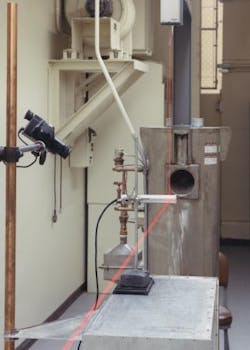Quantum-Cascade Lasers: QCLs do well under proton and gamma irradiation for space qualification
For many spectroscopic and other optical applications in the mid-IR region, there is no better coherent light source than the quantum-cascade laser (QCL). In fact, the well-known Mid-InfraRed Technologies for Health and the Environment (MIRTHE; Princeton, NJ) engineering research center at Princeton University, while not entirely focused on the QCL, benefits greatly from the technology, and its director, Claire Gmachl, is noted for her research in QCLs.
Now, scientists from the Pacific Northwest National Laboratory (PNNL; Richland, WA), the Space Dynamics Laboratory (Logan, UT), and Utah State University (Logan) have done a study on space qualification of QCLs, subjecting them to radiation exposure and then looking at their performance afterward. The results, which could be a boon to future space-science missions, show that Fabry-Perot (FP) QCLs from two different vendors showed no measurable changes in output power, threshold current, and slope efficiency after being subjected to radiation at levels they would encounter in space.
The group tested seven QCLs and one control. Two were made by Hamamatsu (Hamamatsu City, Japan); they emit at 5.3 μm and are mounted epi-side up on a copper mount with as-cleaved facets. The researchers note they do not know many design details of these two lasers. The other five QCLs, plus the experimental control, are from Maxion Technologies/Thorlabs (Jessup, MD); these are based on aluminum indium arsenide/gallium indium arsenide (AlInAs/GaInAs) heterostructures and have a four-quantum-well active region. Two of the Maxion QCLs lase at 8.2 and 5.4 μm respectively, while the other three emit in the 7.3 to 7.8 μm region. All QCLs were burned-in for at least 100 h for the experiment.
Proton and gamma irradiation
The QCLs were subjected to two types of ionizing radiation: cobalt-60 gamma rays, which have 1.17 and 1.33 MeV energies, and 64 MeV protons. Total radiation doses received by the QCLs ranged from 20 to 46.3 krad(SI) (this term specifies the Système International d’Unités, or SI, version of the krad unit). In comparison, a typical satellite at a 700 km altitude and a 60° inclination with aluminum shielding of 0.2 g/cm2 would receive a cumulative dose of 33.3 krad(SI) over a seven-year period. Proton-irradiation testing was done at the University of California at Davis Crocker Nuclear Laboratory; each exposure dose was 10 krad(SI), delivered by a proton fluence of 7.46 × 1010 protons/cm2—a value chosen because it is much higher than the expected proton fluence in relevant conditions in space (for example, the above-mentioned satellite would receive about 3 × 104 protons/cm2 per day).
For the gamma-irradiation work, which was performed at PNNL, the QCLs were placed in a thin plastic box and located near a cobalt-60 source (see figure); three different radiation exposures of 8.77 krad(SI) each were spaced two to three weeks apart, resulting in a total dose of 26.3 krad(SI).
The output characteristics of each QCL were characterized before irradiation using a thermopile detector; the QCL was mounted on a temperature-controlled sink to minimize thermal effects. The lasers were driven at a 50% duty cycle and 100% modulation depth at 40 kHz. One of the most significant origins of nonrepeatability in the experiment was the dismounting and remounting of the lasers on the thermal mount (required to test multiple lasers); to minimize this effect, the researchers averaged 10 different measurements.
Results
Under irradiation by 64 MeV protons, one Hamamatsu QCL showed a small increase in threshold current, but the amount was likely due to measurement uncertainties related to mounting; the second Hamamatsu QCL showed no increase in threshold current. The first Hamamatsu laser and a Maxion laser were then subjected to gamma rays and showed no measurable change in threshold current (the other Hamamatsu laser was damaged in handling during experimentation).
Proton irradiation at a 10 krad(SI) dose was then done on all five Maxion QCLs; all five showed no measurable increase in threshold current. In fact, four of them showed a small decrease. Four of these lasers were then subjected to gamma-ray irradiation; the resulting changes in threshold current and slope efficiency all fell within the measurement uncertainty. Finally, spectral measurements with a Fourier-transform IR (FTIR) spectrometer showed no significant changes in the spectra of any of the QCLs.
The researchers believe that FP-QCLs from other vendors should also be insensitive to radiation exposure. A different type of QCL, the single-mode distributed-feedback (DFB) QCL, should be subjected to its own test to determine its radiation hardness.
REFERENCE
1. T. L. Myers et al., Appl. Opt. 54(3) (Jan. 2015); http://dx.doi.org/10.1364/AO.54.000527.
About the Author
John Wallace
Senior Technical Editor (1998-2022)
John Wallace was with Laser Focus World for nearly 25 years, retiring in late June 2022. He obtained a bachelor's degree in mechanical engineering and physics at Rutgers University and a master's in optical engineering at the University of Rochester. Before becoming an editor, John worked as an engineer at RCA, Exxon, Eastman Kodak, and GCA Corporation.

